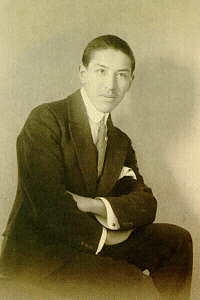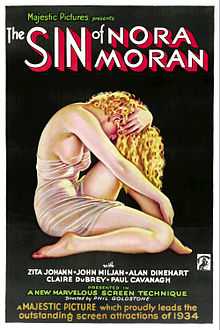Alberto Vargas
| Alberto Vargas | |
|---|---|
 Alberto Vargas in New York, ca. 1919. | |
| Born |
Joaquin Alberto Vargas y Chávez 9 February 1896 Arequipa, Peru |
| Died | 30 December 1982 (aged 86) |
| Nationality | Peruvian |
| Known for | Painter |
Alberto Vargas (9 February 1896 – 30 December 1982) was a noted Peruvian painter of pin-up girls. He is often considered one of the most famous of the pin-up artists. Numerous Vargas paintings have sold and continue to sell for hundreds of thousands of dollars.
Life and career
Born in Arequipa, Peru, Joaquin Alberto Vargas y Chávez moved to the United States in 1916 after studying art in Europe in Zurich and Geneva prior to World War I. While he was in Europe he came upon the French magazine La Vie Parisienne, with a cover by Raphael Kirchner, which he said was a great influence on his work. He was the son of noted Peruvian photographer Max T. Vargas.[1]

Artwork by Alberto Vargas
His early career in New York included work as an artist for the Ziegfeld Follies and for many Hollywood studios. Ziegfeld hung his painting of Olive Thomas at the theater, and she was thought of as one of the earliest Vargas Girls. Vargas' most famous piece of film work was for the poster of the 1933 film The Sin of Nora Moran, which shows a near-naked Zita Johann in a pose of desperation. The poster is frequently named one of the greatest movie posters ever made.[2]

He became widely noted in the 1940s as the creator of iconic World War-II era pin-ups for Esquire magazine known as "Vargas Girls." The nose art of many American and Allied World War II aircraft was inspired and adapted from these Esquire pin-ups, as well those of George Petty, and other artists.
In 2004, Hugh Hefner, the founder and Editor-in-Chief of Playboy, who had previously worked for Esquire, wrote
"The US Post Office attempted to put Esquire out of business in the 1940s by taking away its second-class mailing permit. The Feds objected, most especially, to the cartoons and the pin-up art of Alberto Vargas. Esquire prevailed in the case that went to the Supreme Court, but the magazine dropped the cartoons just to be on the safe side".[3]
A legal dispute with Esquire over the use of the name "Varga" resulted in a judgement against Vargas. He struggled financially until the 1960s when Playboy magazine began to use his work, calling the images "Vargas Girls." His career flourished and he had major exhibitions of his work all over the world.
Vargas' artistic work, paintings and color drawings, were periodically featured in some issues of Playboy magazine in the 1960s and 1970s.
The death of his wife Anna Mae in 1974 left him devastated, and he stopped painting. Anna Mae had been his model and business manager, his muse in every way. The publication of his autobiography in 1978 renewed interest in his work and brought him partially out of his self-imposed retirement to do a few works, such as album covers for The Cars (Candy-O, 1979) and Bernadette Peters (Bernardette Peters, 1980; Now Playing, 1981). He died of a stroke on 30 December 1982, at the age of 86.
Many of Vargas' works from his period with Esquire are now held by the Spencer Museum of Art at the University of Kansas. It was given those works in 1980 along with a large body of other art from the magazine.[4]
At the December 2003 Christies auction of Playboy archives, the 1967 Vargas painting Trick or Treat sold for $71,600.[5]
His work was typically a combination of watercolor and airbrush. His mastery of the airbrush is acknowledged by the founding of the Vargas Award, awarded annually by Airbrush Action Magazine. Despite always using figure models, he often portrayed elegantly dressed, semi-nude to nude women of idealized proportions. Vargas' artistic trait would be slender fingers and toes, with nails often painted red.
Vargas is widely regarded as one of the finest artists in his genre. He also served as a judge for the Miss Universe beauty contest from 1956 to 1958.[6]
Notable women painted by Vargas include Olive Thomas, Billie Burke, Nita Naldi, Marilyn Miller, Paulette Goddard, Bernadette Peters, Irish McCalla and Ruth Etting.[7]
See also
References
- Notes
- ↑ "Vargas", Virtual e-Museum, Unilat.
- ↑ The 25 Best Movie Posters Ever, Premier Magazine.
- ↑ The Cartoons, Playboy 50 Years, ISBN 0-8118-3976-1.
- ↑ Goddard, Stephen, Alberto Vargas and the Esquire Pinup, Spencer Museum of Art, University of Kansas.
- ↑ Valdes-Dapena, Peter (18 December 2003), Playboy art: sex sells, CNN/Money.
- ↑ Miss Universe, Pageant Almanac.
- ↑ Alberto Vargas, Pin-Up Files.
- Bibliography
- Alberto Vargas: Works from the Max Vargas Collection, by Reid Stewart Austin, Hugh Hefner. 144pp (2006) (ISBN 978-0821257920).
- Vargas, by Reid Austin and Alberto Vargas. 127 pp. (1978) (ISBN 0-517-530473 ) (autobiography).
- Varga. The Esquire Years. A Catalogue Raisonné. 176 pp (1987) (ISBN 0-912383-48-8 ).
- The Great American Pin-Up, by Charles G. Martignette and Louis K. Meisel, ISBN 3-8228-1701-5
- Vargas, by Benedikt Taschen, text by Astrid Conte. 79 pp. (1990) (ISBN 3-89450-063-8).
External links
- Alberto Vargas, a history, family photos and gallery.
- Alberto Vargas article in Cigar Aficionado, 100th anniversary 1996
- Vargas on "The Pin-Up Files"
- Alberto Vargas Biography
- Artwork on the American Art Archives web site
|